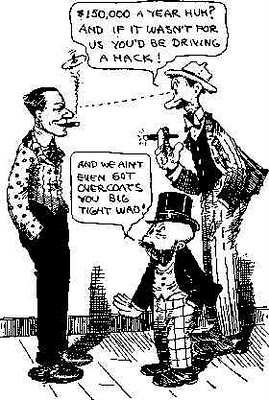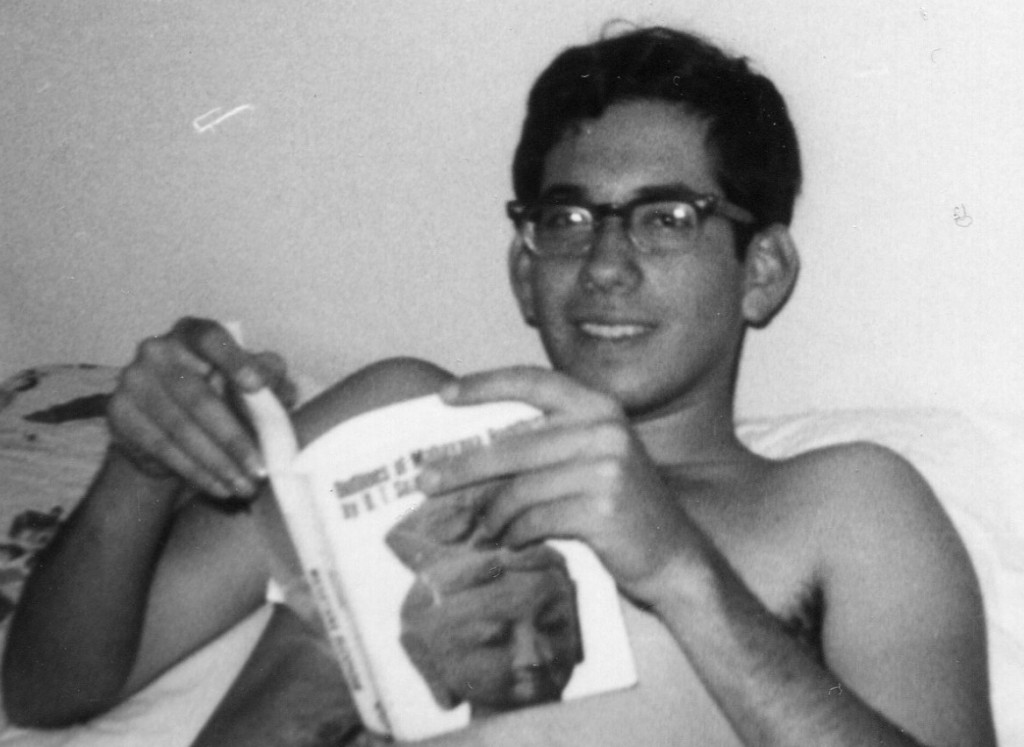When did this post begin? Some would say it began with the Big Bang.
Once the universe was set in motion, this blog post became as inevitable as the formation of the solar system, the emergence of life and consciousness, and Doug Adams’ creation of the Improbability Drive.
I personally think it began in 1966. That was the year that the legendary Alan Watts, the renowned Buddhist[ref] Watts wasn’t strictly a “Buddhist” interpreter. He expoused a mixture of Buddhism, Vedanta, and Taoism, and sometimes his understanding of Zen was a litle idiosyncratic. Nevertheless he was a brilliant and inspired speaker who did much to familiarize Westerners with Eastern Philosophy. [/ref] interpreter, psychedelic advocate, and alcoholic, arrived at my small East-coast liberal arts college to give a series of talks.
It’s said we are born anew every moment, that every moment is a turning point, a hinge of fate. Attending Alan Watts’s talks was certainly a turning point in my life, although I couldn’t have known it at the time.
For one thing, it marked the beginning of a life-long interest in Buddhism. See Exhibit A:
That’s a photo of me reading D.T. Suzuki’s Outlines of Mahayana Buddhism in 1966 taken by my father. I might not be a Buddhist if it hadn’t been for Alan Watts. He was my Dharma door. His talks also sparked an interest in psychedelics, and later that year, while it was still legal, I prepared for taking LSD using The Psychedelic Experience, the Leary-Alpert-Metzner adaptation of the Tibetan Book of the Dead, as my Frommer’s guide. Shortly thereafter I read the Evans-Wentz translation of the Tibetan Book of the Dead which introduced me both to Tibetan Buddhism and C. G. Jung (who wrote the introduction to the book). My ensuing interest in Jung helped spark a growing interest in psychology. I became a Psychology major in 1968. One thing leads to another.
In the same year Alan Watts visited my school, I befriended a fellow undergraduate named Art who was an aspiring comic book artist. We collaborated together on three projects that year. The first was a sophomoric underground comic strip that caused a minor scandal on campus. The second was a dreadful campus radio satire of Star Trek in which Captain James T. Kirk battled a creature made of pure lethargy. The third is the only one I really remember with any degree of clarity. (I know, anyone who remembers the sixties wasn’t really there!)
Those of us with a rapidly approaching sell-by date will remember Mutt and Jeff. 
Mutt and Jeff was a multi-panel comic strip created by Bud Fisher in 1908 that remained in syndication until 1987. Mutt’s the tall one, Jeff’s the short one, and Bud Fisher’s the well-heeled chump on the left.
Inspired by our interest in Zen, Art and I came up with a four-panel Mutt and Jeff homage based on ”Joshu’s Dog” — Case Number One in the Mumonkan. In the first panel Mutt asks Jeff if a dog has a Buddha-nature. In the second panel, Mutt replies ”wu!” In the third panel Mutt glares at Jeff with daggers in his eyes. In the final panel we see poor Jeff in a garbage can with a blackened eye and a banana peel resting on his head. Early twentieth century Zen Masters could be quite fierce!
If my memory serves me correctly, the cartoon eventually appeared in the East Village Other around 1967, but I could be mistaken. In any case, it seems to have subsequently disappeared. Neither Art nor I have a copy, and I’ve been unable to locate it on the internet. Like a Tibetan sand painting, it exemplifies impermanence. Art and I never collaborated on any further projects. We went our separate ways. I went on to graduate school. Art went on to invent the genre of the graphic novel and win the Pulitzer Prize.
The Mutt and Jeff cartoon exemplified the vaudevillian quality of the Zen koan. I’m currently reading Andy Ferguson’s monumental Zen’s Chinese Heritage: The Masters and Their Teachings that was just reissued by Wisdom Publications. The book covers 25 generations of Chinese Ch’an teachers, which means an awful lot of baffling Zen stories drawn primarily from the Compendium of Five Lamps by the eleventh century Zen Master Dachuan Lingyin Puji. The Mutt and Jeff cartoon keeps returning to my mind as I read them. Some of these Zen stories would have made wonderful routines for Borscht Belt comedians. The following is a current favorite of mine. As you read it, just imagine Groucho as Zhizang:
After Zhizang became abbot of the Western Hall, a layperson asked him, ”Is there a heaven and a hell?”
Zhizang said, ”There is.”
The layman then asked, ”Is there really a Buddha, Dharma, and Sangha — the three jewels?”
Zhizang said, ”There are.”
The layman then asked several other questions, and to each Zhizang answered, ”There are.”
The layman said ”Is the master sure there’s no mistake about this?”
Zhizang said, ”When you visited other teachers, what did they say?”
The layman said, ”I once visited Master Jingshan.”
Zhizang said, ”What did Jingshan say to you?”
The layman said, ”He said there wasn’t a single thing.”
Zhizang said, ”Do you have a wife and children?”
The layman said, ”Yes.”
Zhizang said, ”Does Master Jingshan have a wife and children?”
The layman said, ”No.”
Zhizang said, ”Then it’s okay for Jingshan to say there isn’t a single thing.”
The layman bowed, thanking Zhizang, and went away.
It’s a great joke. It has a terrific build up, and Zhizang’s timing’s impeccable.
The story points to the reality of both absolute and relative truth. Zhizang and Jingshan teach the same Zen, but Jingshan does it from the vantage point of absolute truth, Zhizang from relative truth. The joke is that it’s all well and good to dwell on the mountain top of oneness if you don’t have a wife or kids. If you do, however, you have to come down and dwell in the world of the ten thousand things.
It reminds me of Zen Master Hakuin’s colophon to his painting of Eaglehead Mountain:
”Looking above, Eaglehead Mountain —
Looking below, the fishing boats of Shige and Shishihama.”
We have to coordinate the heights of the mountain top with the view below — both equally valid views. If you stay at the top you risk altitude sickness. If you just stay in your little fishing boat, you miss the glorious heights.
I love Zen because it has a sense of humor. It follows Oscar Wilde’s advice that ”Life is too important to be taken seriously.”
Everything is of the utmost importance. We do everything with care, attentiveness, and concern. We just carry the importance lightly.
Sometimes jokes in the West also contain serious messages.
I love the following joke for what it has to say about humility often being egotism in disguise, like a wolf in sheep’s clothing:
”It was Yom Kippur and the cantor left the standard liturgy to improvise before the congregation. ”I’m nothing,” he cried out. ”God, I’m like a worm crawling on his belly, like dust beneath your feet.” He began to wail and rend his clothing. Hearing him, all the rich congregants in the expensive seats in the front of the Synagogue took up his cries of piety. “Forgive us, dear God. We’re nothing. We’re lower than the low.” And they too began to wail and rend their garments. Hearing this, little Mottel the Tailor in the cheap seats way in the back echoed the cry of humility. ”Oh, God,” he said, ”I’m lower than the lowest vermin. I’m garbage! I’m nothing!” With this the congregation stopped its prayers and stared at Mottel. ”Who is he,” the rabbi said incensed, ”to think he’s nothing?”
Who is Jingshan to think there’s not a single thing?



